Spider Lily Plant
Spider Lilies, herbs with moderate growth, prefer moist, well-drained soil and full sun to partial shade. With high moisture needs, they are appreciated for their attractive flowers.
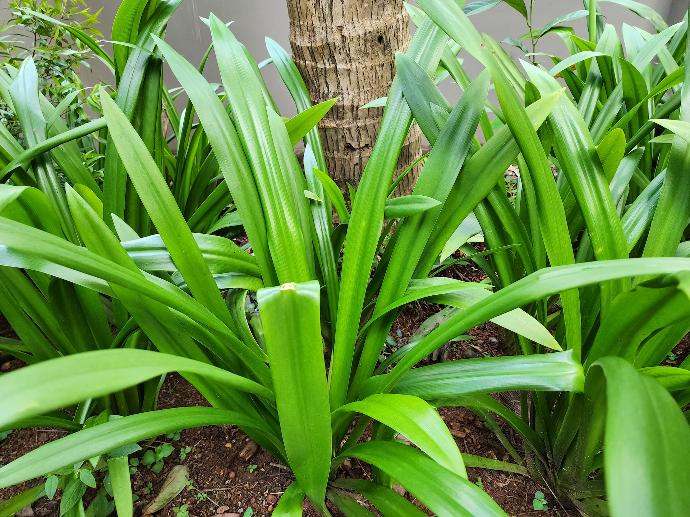
Habit
Herb
Height
0.3-1 m
Growth
Moderate
Soil
Well-drained, sandy
Shade
Full Sun to Partial Shade
Moisture
High
Edible
No
Medicinal
No
Origin
Tropical America
Climatic Condition
Tropical, Subtropical
Temperature (°)
20-30°C
Humidity (%)
60-80%
Potting media
Loamy, peat
Fertilizers
Balanced, organic NPK
Watering
Regular
Plant Weight
100-300 g
Flowering Time
Spring, Summer
Soil Ph level
6.0 - 7.5
Water Ph level
6.0 - 7.0
Soil EC
1-2 dS/m
Yield Per Plant
Ornamental, medicinal
NPK ratio
10:10:10
life Span
Perennial
Health Benefits
Air-purifying, ornamental
Suggested Grow Media or Potting Mix ?
50% peat, 25% perlite, 25% compost
Suggested Fertigation/Fertilizers
Fertilize every 2-3 weeks with a balanced fertilizer.
Common Diseases and Remedies
Bulb rot.
Oval or circular spots on leaves
Remove the Infected Part of the plant and burn them.
HEALTH BENEFITS
· Some species contain alkaloids with potential medicinal uses.
· Used in traditional remedies for pain relief.
What Is An Spider lily plant ?
Spider lily is the common name for many plants in the Amaryllidaceae family known for their spider-like flowers. The best-known species include Hymenocallis and Lycoris, both of which produce beautiful flowers with long, thin leaves that resemble spider legs.
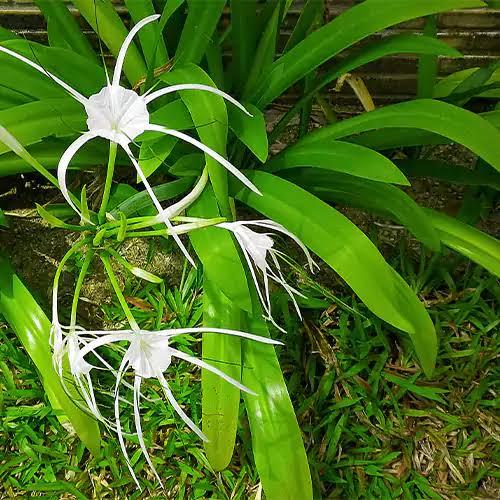
What Are The Different Types Of Spider lily Plants?
1. Hymenocallis:
Hymenocallis is Known for its large, white, spider-like flowers.
2. Lycoris:
Lycoris is Commonly called surprise lilies or resurrection lilies, lilies have colorful, spider-shaped flowers that emerge from bare stems.
3. Crinum:
Although not commonly known as spider lilies, some species of Crinum, such as Crinum asiaticum, produce flowers with a similar appearance.
4. Pancratium:
Another genus of the Amaryllidaceae family, Pancratium species also have spider-like flowers, but they are generally smaller than Hymenocallis or Lycoris.
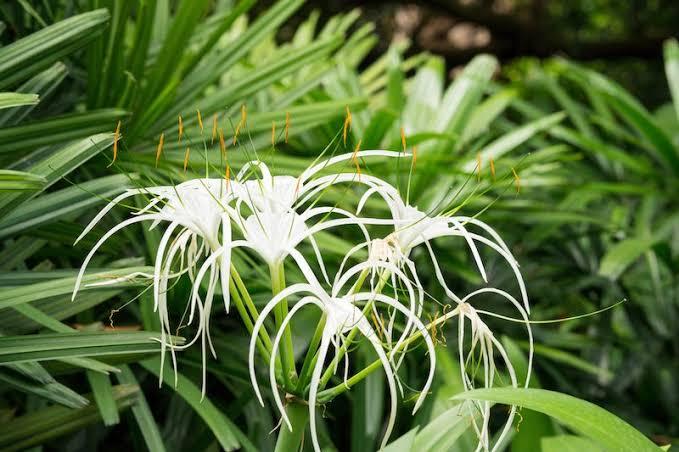
1. Loction
Spider lilies generally prefer well-drained soil and part to full sun. They will have different preferences depending on the specific type, but in general the chosen location has the following characteristics:
1. partial Sunlight: Most spider lilies thrive in full sun areas, but some species can tolerate partial shade.
2. Well-drained soil: Spider lilies like well-drained soil that does not collect water as they are prone to root rot.
3. Adequate space: Plant spider lilies where they have enough space to spread out, as they can cluster together and form groups over time.
2. Sun light
Spider lilies generally prefer full to partial sun. They generally thrive where they receive at least 6 to 8 hours of sunlight per day. However, some species, such as Lycoris lycoris, can tolerate partial shade. The specific requirements of the species you are growing should be taken into account and the date adjusted accordingly. If in doubt, choose a sunny location to encourage good growth and beautiful flowers.
3. Soil
Spider lilies thrive in well-drained soil rich in organic matter. A good soil mix for growing spider lily plants usually includes:
1. Loam: A mixture of sand, silt and clay that provides good drainage while retaining some water and nutrients.
2. Organic matter: Compost, decomposed manure or leaf mold can be added to the soil to improve fertility and texture.
3. pH value: Spider lilies generally prefer slightly acidic soil to neutral soil with a pH between 6.0 and 7.0. You can test your soil's pH and adjust it if necessary using amendments such as lime or sulfur.
4. Hydration
Spider lilies love normal soil, but root rot is easy if the soil is waterlogged. Regular watering throughout the growing season is important, especially during drought or hot periods.
1. Establishment Phase: Newly planted spider plants need to be well watered to form a solid foundation. During this time, keep the soil constantly moist, but not waterlogged.
2. Growing season: Water spider plants regularly throughout the growing season to keep the soil balanced. Water deeply when the topsoil feels dry to the touch.
3. Prevent waterlogging: Ensure adequate soil drainage to prevent waterlogging that will cause root rot. Avoid overhead watering as it encourages fungal diseases. Instead, water at the base of the plant to reduce moisture on the leaves.
4. Reduce watering in winter: Spider lilies often go into dormancy in winter, so watering needs to be reduced during this time. Allow the soil to dry out slightly from water to prevent rotting.
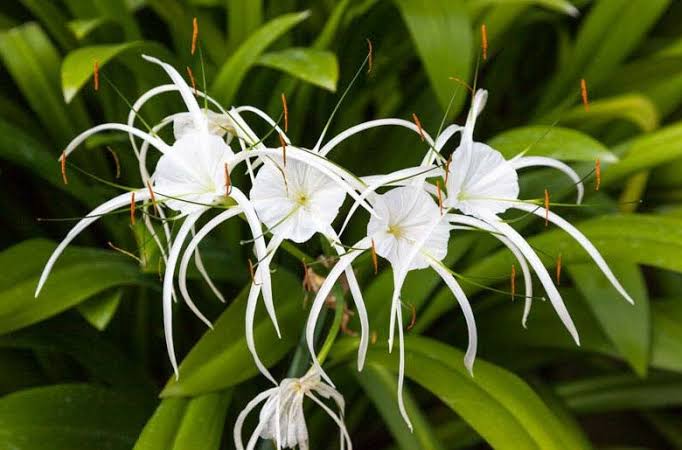
5. Nourishment
spider lilies need a variety of nutrients that are important for healthy growth. These nutrients are usually obtained from soil or fertilization. The main nutrients required for spider plants are:
1. Nitrogen (N): Nitrogen is essential to support lush, green leaves and overall plant growth. It plays an important role in photosynthesis and protein synthesis.
2. Phosphorus (P): Phosphorus is necessary for root growth, flower production and fruit production. It helps strengthen the foundation and improve all important herbs.
3. Potassium (K): Potassium is important in regulating many physiological processes in plants, including water use, transport and immunity. It also contributes to the overall health and vitality of the plant.
In addition to these essential nutrients, spider lilies also need secondary nutrients and micronutrients, although to a lesser extent. These include:
- Calcium (Ca)
- Magnesium (Mg)
- Sulfur (S)
- Iron (Fe)
- Zinc (Zn)
- Manganese (Mn)
- Copper (Cu)
- Molybdenum (Mo)
- Boron (B)
6. Issues
Although spider lilies are generally strong plants, they still face some problems:
1. Root rot: Excessive water or poor soil causes root rot, especially in spider plants. To avoid this, make sure the soil is well-drained and avoid overwatering, especially during the dormant period.
2. Pests: Spider lilies can attract pests such as aphids, spider mites or red oysters. These pests can usually be controlled with insecticides or herbicides.
3. Fungal diseases: Spider lilies are susceptible to fungal diseases such as leaf mold or gray mold, especially in humid conditions. To prevent fungal diseases, do not drink too much water and ensure there is enough air around the plant.
4. Bulb rot: Improper planting depth or excessive moisture can cause spider lily eyes to rot. To avoid this problem, plant the corms at the correct depth and ensure good drainage.
5. Lack of flowering: Spider lilies will not bloom if they do not receive enough sunlight or if they are planted in soil lacking nutrients. Make sure the plants receive full sun and consider fertilizing with a balanced fertilizer to encourage flowering.
7. What are the benefits of Spider lily plant ?
Growing spider lily plants can provide many benefits:
1. Beautiful flowers: Spider lilies create an eye-catching, spider-like flower that adds interest to gardens and landscapes. Their unique appearance enhances the beauty of any outdoor space.
2. Low maintenance: Spider lilies are generally easy to grow and require minimal maintenance. They are resistant to drought and pests and diseases, making them a good choice for busy gardeners.
3. Attract pollinators: Spider lily flowers attract pollinators such as bees, butterflies and hummingbirds, which contribute to biodiversity and ecosystem health in your garden.
4. Naturalizing effect: Many spider lily varieties have a tendency to grow and form clumps at times, creating a naturalized appearance in the garden. This can help fill in bumps and create a more aesthetically pleasing design.
5. Versatility: Spider lilies can be grown in many places, including flower beds, borders, containers and naturalized areas. They can also grow in different types of soil and light, allowing them to adapt to different environments.
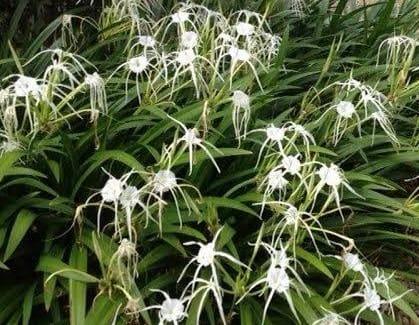
FAQs About Growing Spider lily Plant
1. When is the best time to plant spider lily bulbs?
The best time to plant spider lily bulbs is in the spring or early summer, after the last frost has passed. This allows them to establish their root systems before the onset of winter dormancy.
2. How do I fertilize spider lily plants?
Fertilize spider lily plants with a balanced, slow-release fertilizer in the spring, as new growth begins. Follow the manufacturer's instructions for application rates, and avoid overfertilizing, which can lead to excessive foliage growth at the expense of flowering.
3. Do spider lilies need to be divided?
Over time, spider lily bulbs may multiply and form clumps. Dividing these clumps every few years can help rejuvenate the plants and prevent overcrowding. Divide spider lilies in the fall, after the foliage has died back.
4. Are spider lilies toxic to pets?
Yes, spider lilies are toxic to cats and dogs if ingested. Keep them out of reach of pets, and be cautious when planting them in areas frequented by animals.
5. Can spider lilies be grown indoors?
While spider lilies are typically grown outdoors, they can be grown indoors in containers with proper care. Provide them with bright, indirect light and a well-draining potting mix, and water them regularly to keep the soil evenly moist.